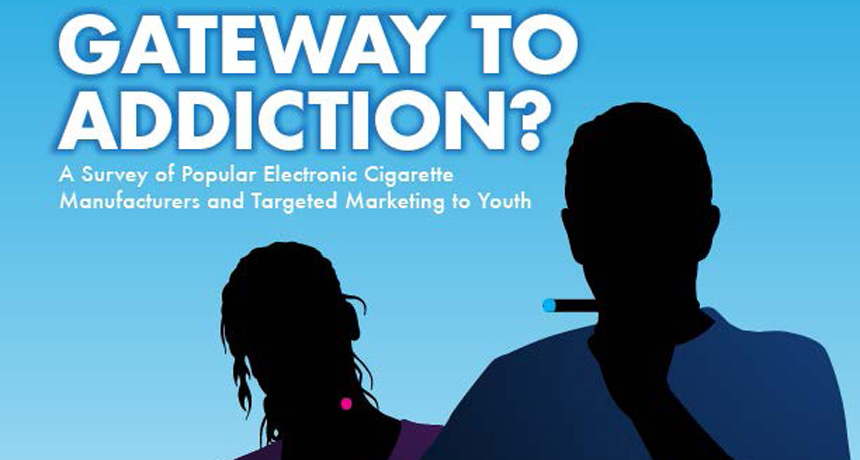E-cigarette makers focus on teens
A new report from the U.S. Congress charges that e-cigarette makers are targeting their addictive products at people too young to smoke

This image is part of the cover of an April 14 report issued by nine U.S. senators and two House members. The report looked into how companies that make e-cigarettes advertise their products, who they target with the advertising, and what is known about the ingredients in vaping products.
Sen. Richard J. Durbin, Rep. Henry Waxman, et al.
By Janet Raloff
Electronic-cigarette makers “are aggressively promoting their products using techniques and venues that appeal to youth,” a new report finds. It concludes that the U.S. government “should act quickly” to issue new laws.
The offices of 11 Democratic Senate and House members issued the report on April 14. In it, the writers argue that new laws should end the targeting of e-cigarette advertising at teens. The report also argues that there should be laws that ban the sale of these potentially addictive products to anyone under the age of 18.
E-cigarettes were developed as a way to help smokers stop using tobacco. But more and more people — especially teens— use these devices for fun and to look stylish. Scientists have begun to worry that teens might face harm from the nicotine and other substances in these products.
Nicotine is a natural chemical found in tobacco and other plants. It is responsible for the buzz smokers get from tobacco. It also is the chemical that makes tobacco addictive. Physicians worry that teens who practice vaping — the term for “smoking” electronic cigarettes — may develop an addiction to nicotine. And they note that nicotine can be toxic. Researchers have identified other toxic ingredients, as well, in some flavorings used in e-cigarettes.
But few scientists have taken a comprehensive look at how e-cigarette companies advertise their products. That’s where the new congressional report fits in. It documents the practices of nine major companies making e-cigarettes.
Last September, the staff of these lawmakers contacted e-cigarette companies. They asked the companies to answer a list of questions. Those staff members also looked at packaging materials, product labels and company websites. And they asked what role the U.S. Food and Drug Administration (FDA) can or should take to control youth access to e-cigarettes.
How companies can target teens
Based on what they learned, authors of the new report conclude that e-cigarettes should be regulated, much as tobacco products are now.
Federal law gives the FDA authority to regulate cigarettes and other tobacco products. Their sale, for instance, is banned for anyone under the age of 18. (Some states and towns are even more restrictive.) But these rules do not apply to e-cigarettes.The FDA bans tobacco companies from sponsoring youth-oriented events and giveaways. Many e-cigarette companies now promote their products by sponsoring sporting, musical and other events that appeal to teens, the new survey finds. In addition, these companies sometimes give away free vaping products.
FDA rules ban the sale of tobacco laced with flavorings. This is intended to limit the appeal of tobacco products to kids. Yet the vapors inhaled from e-cigarettes come from a solution that can appeal to children. Flavors include fruits, candy, ice cream and more.
Federal rules say that cigarettes must be sold in face-to-face transactions. That’s so the seller can confirm the age of whoever buys the product. No such limits apply to e-cigarettes.
Twenty-eight states (including New York, Illinois and California) have banned e-cigarette sales to minors. However, “industry self-regulation is the only way to prevent minors from buying e-cigarettes” in all other states, the report notes. Some vaping-product makers have asked stores to sell their products to adults only. Yet just three of eight of the surveyed companies say they actually check to see that stores do this.

Have you seen an e-cigarette ad? If not, you may very soon. The congressional report found that among companies that would share financial information, one had increased its spending on advertising for vaping products by 64 percent between 2012 and 2013. Another two companies said they tripled their spending last year.
A 1970 law bans cigarette ads on U.S. radio and TV shows. The idea was to limit a child’s access to such ads. This law does not apply to ads for vaping products. And indeed, seven of the nine companies surveyed said they were advertising on radio and TV. Those ads have run during the Super Bowl and Academy Awards, and on sports networks. It’s certainly possible that kids are being exposed to this advertising, the congressional report concludes.
E-cigarette companies also reach out to potential new users via social media, including Facebook, Twitter, YouTube and Instagram. Some companies restrict comments or “likes” from minors. But others don’t, the congressional study found — even though such tools are available to them.
Health concerns abound
The FDA requires labels warning of health risks on all cigarette packaging. Makers of vaping products do not have to carry such warnings. Still, eight of the nine surveyed companies say they do include some type of warning. Many include a statement saying that vaping products contain nicotine. The labels also state that the State of California says this chemical can cause birth defects or other reproductive harm. Such labels usually also warn that pregnant women should not vape.
Other warning labels say “this product does not treat, diagnose or cure any disease.” Or they can state that nicotine may pose risks to people with heart disease, high blood pressure and diabetes.
Such warnings are not likely to scare off teens. The risks would appear largely for pregnant women and older people with chronic disease.
Yet there may be risks to teens. Such as from that nicotine.
A 2014 report by the U.S. Surgeon General summarized decades of research on nicotine effects. Those findings “suggest that exposure to nicotine in youth increases the risk of nicotine addiction,” the new report notes. The report also pointed to data showing that “nicotine exposure during adolescence, a critical window for brain development, may have lasting adverse consequences.”

The FDA notes that e-cigarettes have not been fully studied, so users “currently don’t know the potential risks.” The FDA doesn’t even know to what chemicals a user might be exposed. One reason, the report notes: “E-cigarette manufacturers are currently not required to disclose to FDA a list of all ingredients.” And they don’t have to make available reports of harm linked to their products.
Several studies have shown some vaping products can contain substances that the FDA has already identified as being harmful or potentially harmful. Among them are heavy metals such as cadmium, nickel and lead. E-cigarette vapors also may include toxic chemicals such as formaldehyde, acetaldehyde, acrolein, toluene and nitrosamines.
Recommendations to act
The new report recommends that the FDA move promptly to issue new rules that would prevent adolescent use of vaping products. Because research indicates nicotine can be especially harmful to children and teens, the report asks makers of vaping products to ban sales to minors, require face-to-face sales to adults and demand proof of any buyer’s age.
Finally, the report recommends that the FDA require “strong, uniform labels” on e-cigarettes and vaping products warning of health risks that may be linked to them.
Power Words
addiction The uncontrolled use of a habit-forming drug or uncontrolled and unhealthy habit (such as video game playing or phone texting). It results from an illness triggered by brain changes that occur after using some drugs or engaging in some extremely pleasurable activities. Persons with an addiction will feel a compelling need to use a drug (which can be alcohol, the nicotine in tobacco, a prescription drug or an illegal chemical such as cocaine or heroin), even when the user knows that doing so risks severe health or legal consequences.
adolescence A transitional stage of physical and psychological development that begins at the onset of puberty, typically between the ages of 11 and 13, and ends with adulthood.
Centers for Disease Control and Prevention, or CDCAn agency of the U.S. Department of Health and Human Services, CDC is charged with protecting public health and safety by working to control and prevent disease, injury and disabilities. It does this by investigating disease outbreaks, tracking exposures by Americans to infections and toxic chemicals, and regularly surveying diet and other habits among a representative cross-section of all Americans.
Congress The part of the U.S. federal government charged with writing laws, setting the U.S. budget, and confirming many presidential appointments to the courts, to represent the U.S. government interests overseas and to run administrative agencies. The U.S. Congress is made of two parts: the Senate, consisting of two members from each state, and the House of Representatives, which consists of a total of 435 members, with at least one from each state (and many more for the bigger states).
e-cigarette (short for electronic cigarette) Battery-powered devices that disperse nicotine and other chemicals as tiny airborne particles that users can inhale.
federal Of or related to a country’s national government (not to any state or local government within that nation). For instance, the National Science Foundation and National Institutes of Health are both agencies of the U.S. federal government.
Food and Drug Administration (or FDA) A part of the U.S. Department of Health and Human Services, FDA is charged with overseeing the safety of many products. For instance, it is responsible for making sure drugs are properly labeled, safe and effective; that cosmetics and food supplements are safe and properly labeled; and that tobacco products are regulated.
nicotine A colorless, oily chemical produced in tobacco and certain other plants. It creates the ‘buzz’ effect associated with smoking. It also is highly addictive, making it hard for smokers to give us their use of cigarettes. The chemical is also a poison, sometimes used as a pesticide to kill insects and even some invasive snakes or frogs.
Surgeon General A doctor who serves as the leading spokesperson on public health from within the U.S. government. This person also serves as the primary deputy on medical matters to the Assistant Secretary for Health (within the Department of Health and Human Services).
tobacco A plant cultivated for its leaves. Dried tobacco leaves are burned in cigars, cigarettes, and pipes. Tobacco leaves are also sometimes chewed. The main constituent of tobacco leaves is nicotine.
toxicPoisonous or able to harm or kill cells, tissues or whole organisms.
vaping Slang term for the inhalation of vapors from e-cigarettes.
vapors Fumes released when a liquid transforms to a gas, usually as a result of heating.







